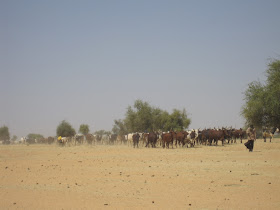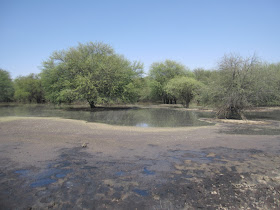 |
| Coffee-time while waiting for the ferry |
 |
| Ferry dropping off south of the Niger bend |
The next day I hired a 4X4 to drive across the Sahel in search of the desert elephants of Mali. The plan to see the elephants was initially not in my core things to do in Mali but I was ahead of my schedule by two to three days so the previous day in Timbuktu I made plans to rented a 4X4 thinking I can cram this into my itinerary. I was lucky in the sense that my time to visit coincided with the elephants being in Mali, however they inhabit a large tract of land called the “Reserve de Douentza”. The only way to see the elephants was to hire a decent 4X4 and then tract them in the vast expanses of the Sahelian landscape.
 |
| Harsh but beautiful Sahel |
Ismail asked me if he could ride along for the next couple days and considering the fact that it was only me and the driver who were going and we had ample space in the vehicle I though it was fine to get the kid along. It also helped that Ismail knew a little English which my driver cum guide did not so he would definitely be of help if I needed to converse with the driver.
 |
| Last hamlet before the reserve |
 |
| Bella kids |
 |
| Lake Benzema...the one that was featured in the National Geographic's "Great Migrations" episode |
 |
| Driving throguh the Reserve de Douenza |

We started out at 5am in the morning as we wanted to catch the first ferry departing the port of Kourioume to bring us back to the region south of the Niger Bend which is a region where the river takes a dramatic right. We warmed up that chilly morning by having some excellent coffee and Timbuktu bread as we waited for all the vehicles to load the ferry.
A couple hour or so later we took a detour to enter the reserve digressing from the main dirt road that went all the way to the town of Douentza. For the next 5-6 hours we were tracking the elephants in the vast dry expanse of the Sahel.
 |
| Cattle herders in the Sahel |
Now some people might think that well…they are elephants and how different can they be and after having seen Asian elephants in India and the African species in South Africa and Swaziland was there a real need to go looking for them in this inhospitable region of Mali. The truth is that these elephants are like no other. They are the last surviving heard of the Saharan elephants. Every year then migrate from Burkina Faso to Mali in the dry months where the seasonal lakes and waterholes formed by the flooding of Rive Niger sustain them. They were also recently depicted in National Geographic’s Great Migrations and probably that’s where my curiosity for these desert elephants came from.
 |
| Getting leads from the kids |
 |
| A Tuareg cattle hearder |
 |
| We finally found the elephants beyond the bush...the region was lush with Acacia trees due to water |
The ride through the harsh Sahelian landscape was a one of a kind experience. We were tracking these elephants in this arid, dusty and somewhat sandy region. Sure, we did not encounter a myriad of savanna creatures like a typical African safari but this ride was up there and perhaps even better that the ones I took in South Africa and Swaziland. The thing that makes it unique is its remoteness, its isolation, its breathtakingly harsh but beautiful landscape, it’s small, isolated and sparsely populated pastoral hamlets and the fact that the elephants could be located anywhere over a vast tract of land so there was no guarantee of seeing them. For the whole day that we were in the reserve we did not encounter a single motorized vehicle which speak of the remoteness of this place from modern development.
 |
| Stripping for the bark |
 |
| Contrast |
We were tracking the elephants by moving from one lake to another to see signs of elephant tracks and dung. When that failed we stopped by at hamlets to ask them if they had seen any elephants recently. The best leads came from the cattle herders who where herding their cattle. Our driver was pretty adept as a tracker and it was good that he knew the area and its people otherwise it would be nigh impossible to do it by oneself. Looking at the cattle herders leading their cattle in this dry and dusty region, I could not help but think of the future problems that lie in wait for the locals as the land can support only so much cattle and with population explosion all over Mali, and the increasing desertification of the Sahel, it will be tough to sustains the people, especially if there is a reoccurrence of the drought that hit this region in the
 |
| With my driver and guide |
Around mid-afternoon, we came up to a lake where we found fresh dung at which point we got out of the vehicle and started tracking the elephants through the thick acacia bush immediately surrounding the lake. It took us a further 30mins to finally see the elephants and it was a wonderful sight of a head of 8-10 elephants lead by their matriarch. I took cover under an acacia tree and admired the elephants which were the biggest that I have seen (evidently this desert subspecies is the biggest in the world).
 |
| Tuareg normads returning from the market at Hombori |
 |
| Market at Hombori with the Hombori Tondo mountain in the background |
Forty minutes with these magnificent creatures and I still did not want to leave them. Finally the elephants moved along in thicker busy and we left them along to proceed towards the village of Hombori along the highway between Douentza and Gao.
 |
| Closing time |
We reached the village of Hombori around 4:30pm and it was just in time to catch another wonderful sight of a typical Malian market day with the stunning Hombori Tondo Mountain providing a spectacular backdrop to the colorful market scene. We decided to sleep in a campement in Hombori that night with the plan of hiking around the mountains the next day.







 We started out at 5am in the morning as we wanted to catch the first ferry departing the port of Kourioume to bring us back to the region south of the Niger Bend which is a region where the river takes a dramatic right. We warmed up that chilly morning by having some excellent coffee and Timbuktu bread as we waited for all the vehicles to load the ferry.
We started out at 5am in the morning as we wanted to catch the first ferry departing the port of Kourioume to bring us back to the region south of the Niger Bend which is a region where the river takes a dramatic right. We warmed up that chilly morning by having some excellent coffee and Timbuktu bread as we waited for all the vehicles to load the ferry.










No comments:
Post a Comment